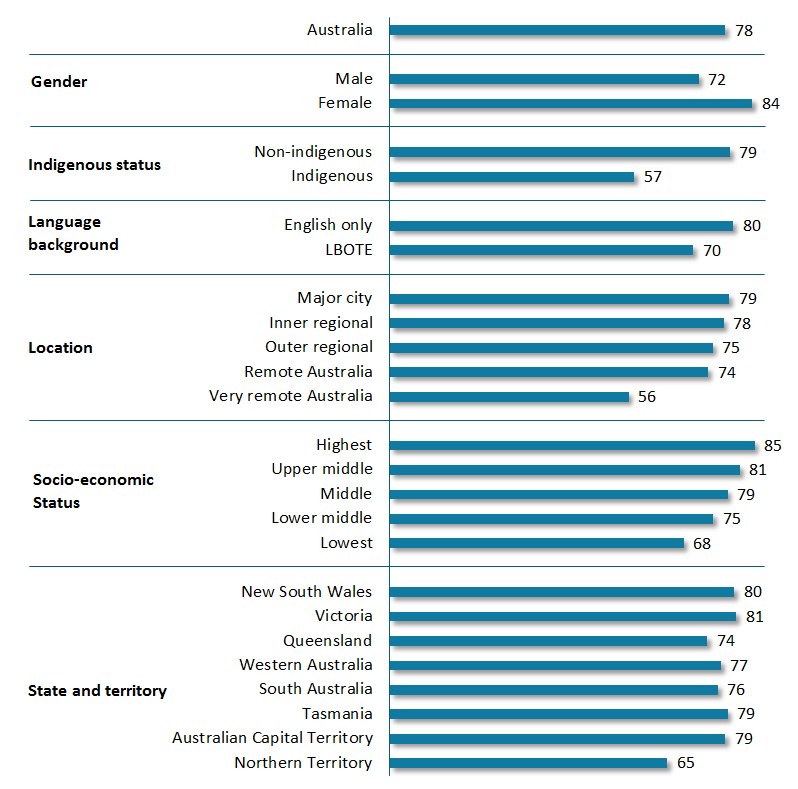Early years: Gaps in educational opportunity evident at school entry

Starting school is a critical time in every child’s life. Their readiness to learn when they enter school and their school’s capacity to meet their needs has a major impact on how they progress throughout their school years.
Yet not all Australian children have an equal chance of meeting this milestone – and those most in need often struggle to catch up.
Educational opportunity in Australia 2015 is one of the most comprehensive data studies of Australia’s education system. It examines young people’s progress on four key educational milestones, from the early years right through to young adulthood. In this fact sheet we look at the early years milestone, when children are aged 4–5 years.
Key findings
- There are already big differences in children’s development by the time they start school.
- Over three-quarters (78 per cent) of Australian children aged 4–5 years meet the milestone at the point of entry to school, which increases their chances of a successful transition to school.
- An estimated 68,000 4-5 year olds (22 per cent) start school each year vulnerable or at risk on one or more developmental domains; this means they are less likely to be able to take full advantage of the opportunitites school has to offer.
- Indigenous children are over two times more likely to be not fully prepared for school than non-Indigenous children (43 per cent versus 21 per cent).
- Males are more likely to be vulnerable or at risk on one or more developmental domains than females at this milestone (28 per cent of males versus 16 per cent of females).
- Children who are missing out at this milestone are more likely to have lower quality early childhood education services and schools in their area.
- Of all the factors that increase the risk of not meeting the milestone at school entry, a child’s socio-economic background has the strongest effect.
Percentage of children meeting the early years milestone

Graph text alternative
Graph showing the percentage of children meeting the early years milestone at age 4-5. The data shows that 78 per cent of children meet this milestone and then shows percentages by gender, Indigenous status, language background, location, socio-economic status and state/territory. The results are as follows: Gender - 72% of males, 84% of females; Indigenous status - Indigenous 57%, non-Indigenous 79%; Language background - English only 80%, LBOTE 70%; Location - ranging from 56% of those in very remote Australia to 79% of those in major cities; Socio-economic status (SES) - increasing as SES increases, from 68% lowest to 85% highest; State/territory - ranging from 65% in Northern Territory to 81% in Victoria.
Source: Educational opportunity in Australia 2015, CIRES for the Mitchell Institute
What does this tell us?
A child’s readiness for school is a clear and compelling indicator of a high quality and effective education system. During the early years of learning, children gain the foundational skills they need to thrive and learn, and fulfil their potential as they progress through their school years and into early adulthood. Parents play a critical part during this developmental phase, alongside a quality system of learning and development.
But this research shows that almost one-quarter of young children living in Australia – an estimated 68,000 children each year – are not adequately supported by our education system to achieve this milestone. This group contains a disproportionate number of children from socio-economically disadvantaged backgrounds, including many Indigenous children. Importantly, the widest gaps between the most advantaged and least advantaged students appear on the dimensions of school readiness that matter most for later learning: language and cognitive skills, and general knowledge and communication.
The most disadvantaged children are more than twice as likely as the most advantaged to miss out on their first education milestone.
These gaps may partly arise from differences in participation. Government and research data show that Australian children from socio-economically disadvantaged families spend less time in early childhood education and care services than more advantaged children. This means they have fewer opportunities to capitalise on the benefits that the education system has to offer in the early years.
Substantial gains have been made over the past decade, but we still have a long way to go in terms of recognising the true value of early learning and ensuring all children have the opportunity to benefit.
Unlike other stages of education, early childhood is still often treated as a workforce participation issue. Recent policy changes, such as new ‘activity tests’, requiring parents to be working or actively looking for work to access subsidies, further reinforce workforce participation as the primary goal of government in supporting early childhood services. It’s not hard to imagine the impact on the children of parents ineligible for subsidies if they are blocked from accessing vital pre-school education, nor the longer term outcomes as they get older.
But addressing these kinds of barriers to early childhood services are not enough. Communities with higher proportions of children in need are more likely to be served by early childhood services rated below national standards. State, Territory and Local Governments need to work with the Commonwealth to address the variability in the quality of early childhood services across the country to avoid further entrenching inequity at this early life stage. The National Quality Framework has allowed us to identify issues with service quality and Australia must raise the standards of early learning services in our most disadvantaged communities.
About this milestone - what was measured?
The early years milestone looked at which children were developmentally ready at the point of entry to school, as measured across five domains of the Australian Early Development Census: physical health and wellbeing, social competence, emotional maturity, language and cognitive skills and communication and general knowledge. Children who are “on track” on all five domains are considered developmentally ready for school.
Factsheets in this series
- Fact sheet 1 – Socio-economic disadvantage and educational opportunity persistently linked
- Fact sheet 2 – Early years: Gaps in educational opportunity evident at entry to school
- Fact sheet 3 – Middle years: Achievement gaps widen at Year 7
- Fact sheet 4 – Senior school years: School completion uneven across Australia
- Fact sheet 5 – Post-school years: Many 24 year olds marginalised, but second chances help
- Fact sheet 6 – Young people in rural and remote communities frequently missing out
More information
Educational opportunities in Australia 2015 was prepared by the Centre for International Research on Education Systems at Victoria University for the Mitchell Institute.



